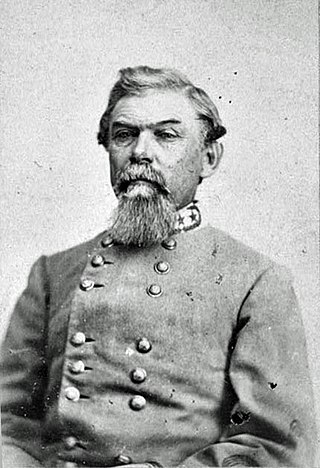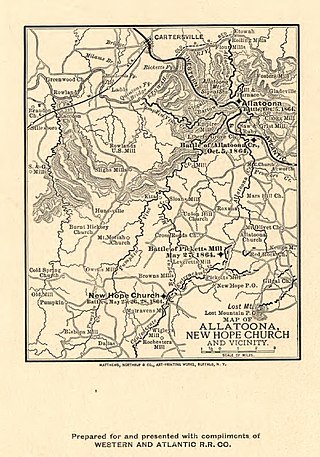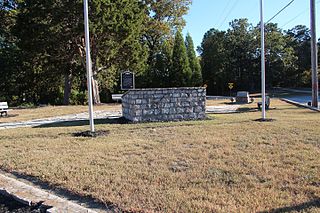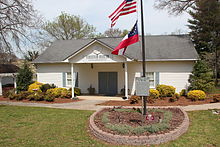
Bartow County is located in the northwestern part of the U.S. state of Georgia. As of the 2020 census, the population was 108,901, up from 100,157 in 2010. The county seat is Cartersville.

Adairsville is a city in Bartow County, Georgia, United States. As of the 2020 census, the city had a population of 4,878. Adairsville is approximately halfway between Atlanta and Chattanooga on Interstate 75. It is 12 miles (19 km) south of Calhoun, 18 miles (29 km) northeast of Rome and 61 miles (98 km) north of Atlanta.

The Battle of Atlanta took place during the Atlanta Campaign of the American Civil War on July 22, 1864, just southeast of Atlanta, Georgia. Continuing their summer campaign to seize the important rail and supply hub of Atlanta, Union forces commanded by William Tecumseh Sherman overwhelmed and defeated Confederate forces defending the city under John Bell Hood. Union Major General James B. McPherson was killed during the battle, the second-highest-ranking Union officer killed in action during the war. Despite the implication of finality in its name, the battle occurred midway through the Atlanta campaign, and the city did not fall until September 2, 1864, after a Union siege and various attempts to seize railroads and supply lines leading to Atlanta. After taking the city, Sherman's troops headed south-southeastward toward Milledgeville, the state capital, and on to Savannah with the March to the Sea.

William Joseph Hardee was a career U.S. Army and Confederate States Army officer. For the U.S. Army, he served in the Second Seminole War and in the Mexican–American War, where he was captured and exchanged. In the American Civil War, he sided with the South and became a general. Hardee served in the Western Theater and quarreled sharply with two of his commanding officers, Braxton Bragg and John Bell Hood. He served in the Atlanta Campaign of 1864 and the Carolinas Campaign of 1865, where he surrendered to General Joseph E. Johnston to William Tecumseh Sherman in April. Hardee's writings about military tactics were widely used on both sides in the conflict.

The Battle of Resaca, from May 13 to 15, 1864, formed part of the Atlanta Campaign during the American Civil War, when a Union force under William Tecumseh Sherman engaged the Confederate Army of Tennessee led by Joseph E. Johnston. The battle was fought in Gordon and Whitfield Counties, Georgia, and is generally viewed as inconclusive.

The Atlanta campaign was a series of battles fought in the Western Theater of the American Civil War throughout northwest Georgia and the area around Atlanta during the summer of 1864. Union Maj. Gen. William Tecumseh Sherman invaded Georgia from the vicinity of Chattanooga, Tennessee, beginning in May 1864, opposed by the Confederate general Joseph E. Johnston.

The Battle of Peachtree Creek was fought in Georgia on July 20, 1864, as part of the Atlanta Campaign in the American Civil War. It was the first major attack by Lt. Gen. John Bell Hood since taking command of the Confederate Army of Tennessee. The attack was against Maj. Gen. William T. Sherman's Union army, which was perched on the doorstep of Atlanta. The main armies in the conflict were the Union Army of the Cumberland, commanded by Maj. Gen. George Henry Thomas and two corps of the Confederate Army of Tennessee.

The Great Locomotive Chase was a military raid that occurred April 12, 1862, in northern Georgia during the American Civil War. Volunteers from the Union Army, led by civilian scout James J. Andrews, commandeered a train, The General, and took it northward toward Chattanooga, Tennessee, doing as much damage as possible to the vital Western and Atlantic Railroad (W&A) line from Atlanta to Chattanooga as they went. They were pursued by Confederate forces at first on foot, and later on a succession of locomotives, including The Texas, for 87 miles (140 km).

The Battle of Kennesaw Mountain was fought on June 27, 1864, during the Atlanta Campaign of the American Civil War. It was the most significant frontal assault launched by Union Maj. Gen. William T. Sherman against the Confederate Army of Tennessee under Gen. Joseph E. Johnston, ending in a tactical defeat for the Union forces. Strategically, however, the battle failed to deliver the result that the Confederacy desperately needed—namely a halt to Sherman's advance on Atlanta.

The Battle of Jonesborough was fought between Union Army forces led by William Tecumseh Sherman and Confederate forces under William J. Hardee during the Atlanta Campaign in the American Civil War. On the first day, on orders from Army of Tennessee commander John Bell Hood, Hardee's troops attacked the Federals and were repulsed with heavy losses. That evening, Hood ordered Hardee to send half his troops back to Atlanta. On the second day, five Union corps converged on Jonesborough. For the only time during the Atlanta Campaign, a major Federal frontal assault succeeded in breaching the Confederate defenses. The attack took 900 prisoners, but the defenders were able to halt the breakthrough and improvise new defenses. Despite facing overwhelming odds, Hardee's corps escaped undetected to the south that evening.

Cassville is an unincorporated community in Bartow County in the U.S. state of Georgia. It was originally the county seat before the name was changed from Cass County. The seat was moved to Cartersville after General Sherman destroyed Cassville in his Atlanta Campaign of 1864.

The Battle of Adairsville was a part of the Atlanta Campaign fought during the American Civil War on May 17, 1864, just northeast of Rome, Georgia. The brief engagement was a Confederate delaying action that allowed General Joseph E. Johnston to bait a trap for the Union army at Cassville.

The Battle of Dallas was an engagement during the Atlanta Campaign in the American Civil War. The Union army of William Tecumseh Sherman and the Confederate army led by Joseph E. Johnston fought a series of battles between May 25 and June 3 along a front stretching northeast from Dallas toward Acworth, Georgia. At Dallas a probe launched by William B. Bate's and William Hicks Jackson's Confederate divisions accidentally turned into a full-scale assault against the defenses of John A. Logan's XV Corps. The attack was driven off with heavy Confederate losses. The previous Union defeats at New Hope Church and the Pickett's Mill are sometimes considered with Dallas as part of one battle.

Allatoona is an unincorporated community in Bartow County, in the U.S. state of Georgia. The community is located along Allatoona Creek, 6 miles (9.7 km) southeast of Cartersville. It was once a small mining community until a dam was erected at the base of the Etowah River, completely flooding the town of Allatoona. It is today perhaps best known as the site of the Battle of Allatoona.

The Battle of New Hope Church was a clash between the Union Army under Major General William T. Sherman and the Confederate Army of Tennessee led by General Joseph E. Johnston during the Atlanta Campaign of the American Civil War. Sherman broke loose from his railroad supply line in a large-scale sweep in an attempt to force Johnston's army to retreat from its strong position south of the Etowah River. Sherman hoped that he had outmaneuvered his opponent, but Johnston rapidly shifted his army to the southwest. When the Union XX Corps under Major General Joseph Hooker tried to force its way through the Confederate lines at New Hope Church, its soldiers were stopped with heavy losses.

The Battle of Pickett's Mill was fought in Paulding County, Georgia, between Union forces under Major General William Tecumseh Sherman and Confederate forces led by General Joseph E. Johnston during the Atlanta Campaign in the American Civil War. Sherman sent Brigadier General Thomas J. Wood's division, supported by other formations, to turn Johnston's right flank, but the Federals were repulsed with heavy casualties when they ran into tenacious Confederate opposition. Author Ambrose Bierce, an eyewitness, later wrote an account of the battle titled The Crime at Pickett's Mill.

The Battle of Kolb's Farm saw a Confederate corps under Lieutenant General John B. Hood attack parts of two Union corps under Major Generals Joseph Hooker and John Schofield. This action was part of the Atlanta campaign of the American Civil War fought between the Confederate Army of Tennessee led by General Joseph E. Johnston and Union forces commanded by Major General William Tecumseh Sherman. Hood believed that he had an opportunity to inflict a defeat on the Union forces in front of his corps and ordered an assault. However, Hooker's and Schofield's troops were deployed in good positions and they repulsed Hood's soldiers with serious losses.

The Battle of Cassville was a clash between the Union Army under Major General William T. Sherman and the Confederate Army of Tennessee led by General Joseph E. Johnston during the Atlanta Campaign of the American Civil War. Johnston attempted to strike a fraction of Sherman's forces with two of his three infantry corps, but the plan miscarried when a Union force appeared from an unexpected direction. Later in the day, Johnston withdrew to a line of field works on a ridge to await attack. However, two of his corps commanders reported that their defenses were enfiladed by Federal artillery fire and that the position could not be held. That night, Johnston decided to withdraw his army south of the Etowah River to a new defense line.
The Battle of Rome Cross Roads, also known as Battle of Rome Crossroads, Skirmish at Rome Crossroads, or Action at Rome Cross-Roads was part of the Atlanta Campaign of the American Civil War. It was fought in Gordon County, Georgia, a short distance west of Calhoun, Georgia, on May 16, 1864. The battle was a limited engagement between Union Army units of the Army of the Tennessee and Confederate States Army units of the Army of Tennessee in the aftermath of the Battle of Resaca, Georgia.

The Battle of Gilgal Church was an action during the Atlanta Campaign in the American Civil War. The Union army of William Tecumseh Sherman and the Confederate army led by Joseph E. Johnston fought a series of battles between June 10 and 19 along a front stretching northeast from Lost Mountain to Pine Mountain to Brushy Mountain. At Gilgal Church, attacks by the divisions of John W. Geary and Daniel Butterfield from Joseph Hooker's XX Corps were repulsed with about 700 casualties by Confederates from William J. Hardee's corps. That day in a separate action, other Union troops overran a Confederate skirmish line, capturing about 300 men. Gilgal Church was part of a series of minor actions that included the Battle of Latimer's Farm on June 17–18.























